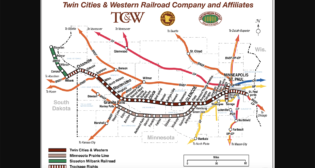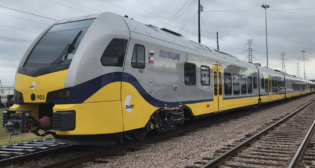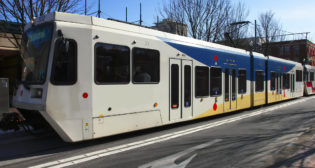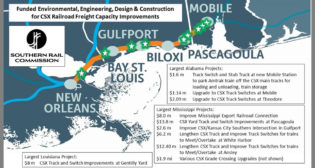Professionals juggle the miscellany of variables associated with grinding to ensure a target profile to manage and extend rail life. Rail remains one of the railroads’ most expensive assets, and employing maintenance practices to meet its useful life can save the industry millions every year.
A target profile
Harsco Rail’s machines grind to a target profile based on desired wheel/rail contact that can vary by location in the track, whether it’s tangent, high rail, or low rail, as well as the degree of curvature in the rail.
Profile grinding is ultimately the basis for controlling wheel/rail contact. By controlling where the wheel contacts the rail, the wear and fatigue of a track is decreased. However, Harsco notes that companies must also take into account the wheel profile when considering the corrugation of rail.
“Desired new and worn wheel profiles are used to help develop the target rail profiles. Thus, if we want to shift the contact from the gauge corner, the target profile will have gauge corner relief, and grinding to that target will help shift the wheel/rail contact,” says Palese.
Equipment that achieves a smooth surface finish and has the flexibility to grind in many different circumstances including corrective profiling, mill scale removal, corrugation, noise and vibration removal, defect control, and work around track obstacles and maintain grind, is important to Dereck Bartz, product manager for Harsco Rail’s grinding equipment and services, because various customers have different specific concerns as it relates to grinding rail.
Harsco Rail notes that grinding has moved beyond a service and is a science that demands innovation and performance, in order to develop a machine that can meet the demands of the track.
Extending useful life
Loram Maintenance of Way, Inc., currently has 248 examples within its template library to grind a three-inch rail, with more templates being added all the time.
“Certainly, high rails, low rails, and tangent rails all deserve their own shape and the diverse wheel profiles found on various systems demand correspondingly unique matching rail shapes,” says Robert Harris, chief engineer, Rail Quality, with Loram. “To assure the rail profile left behind the grinding machine is acceptable, we have various methods of measuring and reporting the compliance to a template, ranging from sophisticated laser-based optical measurement systems linked to GPS tracking systems to manual tools and gauges used by a person on the ground.”
In addition to rail profile, Harris also points to variations in wheel shape as a factor in controlling wheel/rail contact.
“In the ideal case, where all of the wheels on a system are identical and all of the trucks perform flawlessly, it is easy to shape the rail so the contact point can be precisely controlled. When this is done properly, steering of the wheelsets can be optimized and stresses in the wheel and rail can be minimized, reducing damage and therefore costs. In the real world, the same strategy is attempted but the level of precision is lessened and an attempt is made to optimize for the majority of the wheels,” says Harris.
As one of the most capital-heavy assets on the railroad, rail needs to last as long as it can, which is why Harris says the overall focus of rail grinding in heavy haul operations is to extend the useful life of the rail.
“This is done through the application of proper rail shapes, while removing only the steel needed to control surface damage. To accomplish this goal, Loram works with customers to establish proper grinding cycles and offers pre-inspection services to assure the work is planned exactly for each track section prior to the arrival of the grinder. For transit systems, longevity of the rail investment is also a concern, but the primary focus is shifted to factors influencing passenger comfort and environmental concerns, such as reduced noise levels generated in the wheel/rail interface,” says Harris.
Preventive maintenance
Plasser American Corp. provides corrugation and preventive maintenance grinding machines that use an oscillating motion of the grinding stones longitudinally to the rail. The company says the oscillating movement of the grinding units along with the continuous motion of the machine provide for a perfect, smooth rail running surface. A water spray system ensures a dust free environment, and the Plasser grinding process is also spark free. (Illustration, p. 37.)
“One of the major advantages of the Plasser grinding principle is the reduction of noise caused by train traffic on railway lines that run through residential areas. A perfect running surface reduces not only noise emissions, but also improves ride quality and reduces wear on the track and rolling stock,” says Plasser.
The company recommends using an oscillating grinding machine after rotary grinding machines or rail milling machines to eliminate the “chatter” marks usually left behind, thus reducing the noise emissions.Plasser points to tests performed in Germany that have demonstrated that a noise emission reduction of 12 dBA is achievable using the Plasser grinding technology.
An additional advantage that has been studied and demonstrated is that rails treated with a Plasser oscillating grinding machine showed an obvious increase in service life, resulting in higher cost effectiveness.
“In various studies, it has also been documented that the treatment of new rails showed that corrugations occurred much later than on untreated new rail. The reason is the removal of the initial roughness, which occurs during manufacturing. Preventive grinding has proven to be extremely economical and shown surface faults to be delayed by more than 60 million gross tons,” the company says.
Managing rail life
Vossloh Rail Services’ High Speed Grinding (HSG) system is focused on maintenance grinding and designed to maintain the rail profile to minimize the need for corrective grinding.
“Studies have shown that when a rail starts the degradation process, it degrades exponentially. This causes the rail to under-perform and can cause additional problems with track structure and equipment,” says Ron Martin, vice president and general manager at Vossloh Rail Services. “The HSG system, which operates at 50 mph, was developed to allow frequent maintenance cycles without causing disruption to traffic. This allows railroads to achieve and maintain the optimal profile to minimize the degradation process without the need for expensive and time-consuming corrective procedures. When corrective measures or high metal removal rates are required, Vossloh Rail Services relies on our new Rail Milling technology in areas where we are providing the complete ‘Rail Life Management’ for our customers.”
Martin points out that the entire rail/wheel interface is constantly under review and its optimization is best achieved with a higher frequency of maintenance before long-term degradation of the rail profile or failures occur.
“It has been stated that present maintenance frequency is falling further and further behind in maintenance cycles, due to cost and the impact to train delays. Traditional methods require extensive track time, which is very disruptive to train operations. It’s difficult, and will not get easier, to be granted the track time required to maintain the rail to its optimum performance and achieve the longest rail life possible. The less maintenance performed, the shorter the rail life. Under most present scenarios, railroads unable to keep up their maintenance schedules will be faced with much higher rail replacement costs in the future,” says Martin.
The company’s customers are concerned about all areas affecting rail life cycle, and Martin says each railroad, territory, and track section have unique requirements and demands based on a number of variables.
“Because this is a process, every aspect of the maintenance and corrective actions of the rail interface need to achieve the same outcome. If one part of the process is not performed regularly, the optimal interface will be compromised and require additional costly attention. Rail maintenance practices have come a long way in the past several years, and the importance of each aspect has been researched thoroughly with the consequences well documented. Vossloh Rail Services’ goal is to offer the most cost effective systems to help roads achieve the longest rail life cycle possible,” says Martin.
![[Photo by Christopher Rosario U.S. Army Corps of Engineers, Baltimore District]](https://www.railwayage.com/wp-content/uploads/2024/05/dalibowcrush-315x168.jpg)



